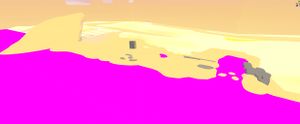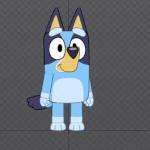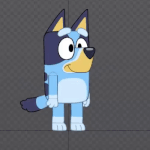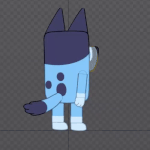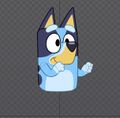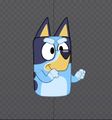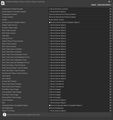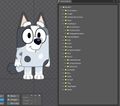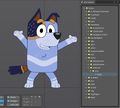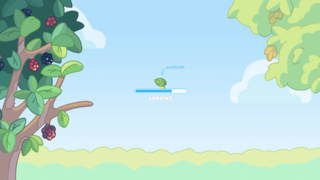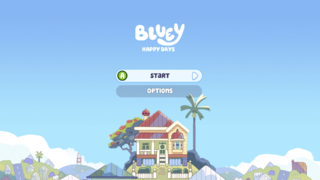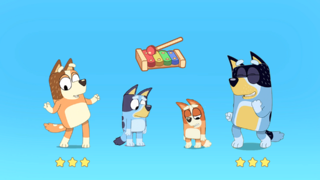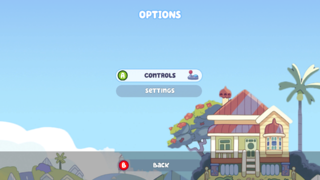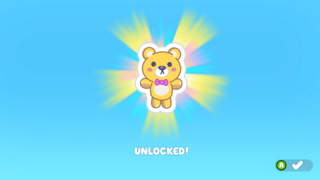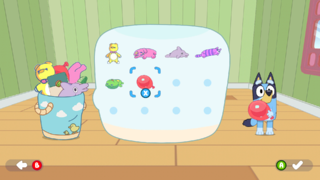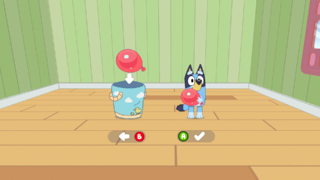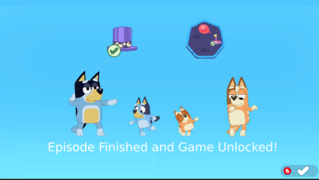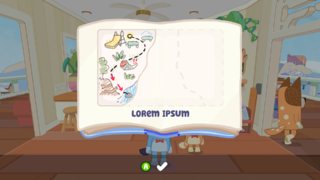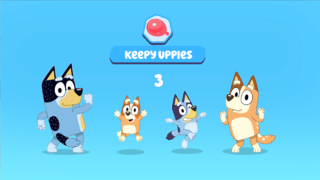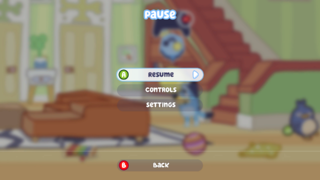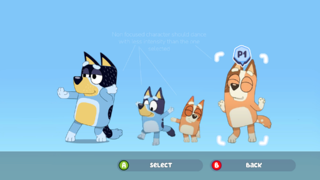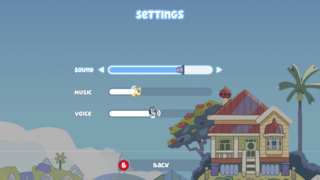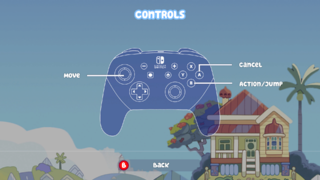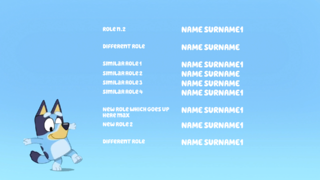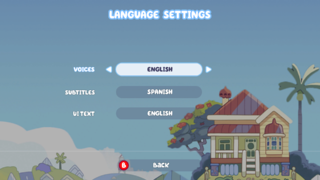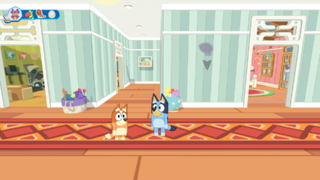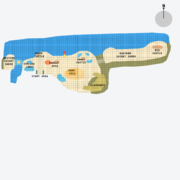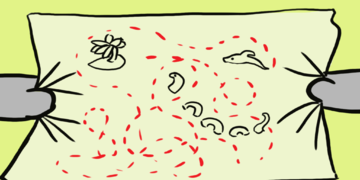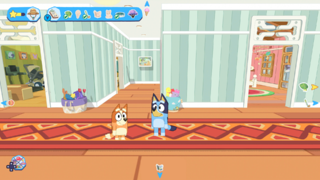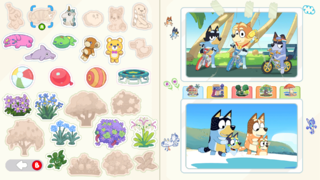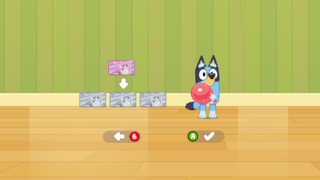Bluey: The Videogame
| Bluey: The Videogame |
|---|
|
Developer: Artax Games
|
| This article has just been started and needs the article basics added. Help us out and add them. |
| This article is a work in progress. ...Well, all the articles here are, in a way. But this one moreso, and the article may contain incomplete information and editor's notes. |
| This page sucks. If you could make it suck less, that would be awesome. Specifically: Almost everything here is a JPEG, and all the images are missing the game name. REPLACE THEM ALL!!! |
Bluey: The Videogame allows players to play as the Heeler family as they search for a treasure from Bandit's past. There aren't long dogs here, but instead hidden content. Also, apparently, Pat/Lucky's Dad was going to be the only non-Heeler present in the game.
| To do: A text file relating to the Burst plugin was accidentally included in the folder Project biscuits_BurstDebugInformation_DoNotShip. Investigate this. |
Contents
Early Level Layouts/Blockouts
The Beach
Invisible in normal gameplay, there exists the original blockout model complete with placeholder probuilder textures leftover in the scene, alongside an "inkscape layout" gameobject, which as the name implies, is the original layout document they used when designing the level.
Just as the blockout was left over in the final level, only disabled, so was this iteration. The final models had yet to be completed, and the water used a different (now deleted and pink) material.
This layout is virtually identical to that of the final layout, so much so had I not provided a screenshot for reference, you might not have noticed the differences. Mostly just missing some models and polish, but also sporting an unused flag right in the center.
The Creek
A remnant from a phase in development where swapping levels was not possible through the sticker book.
Playgrounds
Hidden by default, the playground features some early versions of the final models. The textures no-longer mapped correctly to the surface, or discolored completely. They clip slightly lower into the ground than their final counterparts, but not low enough that they reach the grass below the platform.
Heeler House
Unlike blockouts from other levels which had been leftover, this one was not created for the players to use, but instead entirely for testing AI NPCs. In fact, their original testing NPC is still around as well, hidden out of bounds.
There are quite a few unused skyboxes for windows and doors to certain rooms. Serving no purpose as often the passages they obscure are ones already with a view of the background, or lead into another room.
The backyard also features a handful of objects which are normally unviewable by the player.
Cut Content
Shops
At some point or another a "Shops" system was being developed, with a semi-completed UI panel for it, and leftover objects in the Heeler House level. It would've seen players exchanging dollarbucks they earned throughout their play for various items from two vendors. Muffin, who sells toys from the living room (or possibly the baby room, since a duplicate shops object also appears there), and Pat who sells plants from the backyard. Pat being a notable character here as he is completely cut from the final product. Placing the vendors in game shows nothing but an interact prompt and do not function, but by manually triggering their events via mods we can still activate their respective menus, which can softlock the game. Pat's garden has no items to select, while Muffin's toy shop does, which upon selected, are spawned onto your current position. While the scripts do have functionality for the dollarbuck currency, it does not appear to be implemented, and thus everything is technically free of charge.
Level / Episode Selection
Prior to the sticker book becoming the one-stop shop for all episode, level, and sticker needs, they had developed entirely unique menus and objects for each individual action of that trio. With swapping levels being only possible at either crossroad posts or mailboxes (of which there are many unused copies per level), and episodes being accessible through one of many "Happy Day Selector"s (which are located, but hidden, at virtually every final sticker book location). These objects when re-enabled still fully function, albeit with a little tinkering for the UI to respond as you'd expect.
Episode 5
Not much is known about this cut episode, an empty fifth button on the unused episode select UI is practically all we have to go off of. It would've been the finale for the game, featuring Sticky Gecko as its special sticker. And while purely speculative, it is fair to assume it would've taken place on the otherwise sandbox-only beach level. The episode must've been cancelled fairly early in development, as little-to-no scripts or assets related to it remain.
Crawling
All the playable characters have unused gameplay crawling animations, and the player movement script contains functionality for doing so, but attempting to trigger it either does nothing or breaks the character completely.
Drivable Kart
Complete player animations for entering, driving, and exiting go-karts also exist, though zero functionality or kart models can be found in the game itself.
Activities
The following are activities and interactions that had been developed and have functionality leftover, but went unused in the final release.
- Riding seesaw
- Vollyball minigame
- Shovel, digging holes, planting seeds, growing plants, removing plants
- Claw machine minigame
- Flipping light switches
Playable Characters
Unlike other NPC characters, Muffin and Stripe both contain nearly complete sets of mostly unique player animations in theme with their own characters, including menu selection and activity victory/defeat dances, implying that they were at one point intended to be player selectable and controllable.
Leftover Development Screenshots / Reference Images
For many parts of the game (primarily the user interface), reference images had been created and used in-engine while developers implemented the layouts, but were simply hidden afterward rather than outright being removed.
Unused / Placeholder Audio
Ep1St1LudoStory1
Ep1St1LudoStory2
Ep2TitleScreen
Internal Project Name
In the game's music and sound effect files, it seems to suggest that Bluey: The Videogame was given the internal name of ProjBiscuits. The PC version's folders and main executable are also labeled Project biscuits.
- Pages missing developer references
- Games developed by Artax Games
- Pages missing publisher references
- Games published by Outright Games
- Windows games
- PlayStation 4 games
- Xbox One games
- PlayStation 5 games
- Xbox Series X games
- Nintendo Switch games
- Pages missing date references
- Games released in 2023
- Games released in November
- Games released on November 17
- Games with unused areas
- Games with unused characters
- Games with unused graphics
- Games with unused models
- Articles needing basics
- Works In Progress
- Pages requiring cleanup
- To do
Cleanup > Articles needing basics
Cleanup > Pages missing date references
Cleanup > Pages missing developer references
Cleanup > Pages missing publisher references
Cleanup > Pages requiring cleanup
Cleanup > To do
Cleanup > Works In Progress
Games > Games by content > Games with unused areas
Games > Games by content > Games with unused characters
Games > Games by content > Games with unused graphics
Games > Games by content > Games with unused models
Games > Games by developer > Games developed by Artax Games
Games > Games by platform > Nintendo Switch games
Games > Games by platform > PlayStation 4 games
Games > Games by platform > PlayStation 5 games
Games > Games by platform > Windows games
Games > Games by platform > Xbox One games
Games > Games by platform > Xbox Series X games
Games > Games by publisher > Games published by Outright Games
Games > Games by release date > Games released in 2023
Games > Games by release date > Games released in November
Games > Games by release date > Games released in November > Games released on November 17


